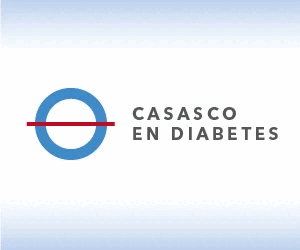¿Cómo individualizar el tratamiento de la hipertensión arterial en las personas con diabetes mellitus tipo 2?
DOI:
https://doi.org/10.47196/diab.v56i2Sup.538Palabras clave:
diabetes, hipertensión arterialResumen
En las personas con diabetes mellitus (DM) e hipertensión arterial (HTA), los objetivos de presión arterial (PA) deben individualizarse considerando el riesgo cardiovascular, los potenciales efectos adversos de los fármacos antihipertensivos, y el costo y las preferencias de los pacientes. En personas con DM y elevado riesgo cardiovascular un objetivo de PA <130/80 mmHg sería apropiado si puede lograrse con seguridad. Si el riesgo cardiovascular es bajo, tratar la HTA con un objetivo <140/90 mmHg. En embarazadas con DM gestacional (DMG) e HTA preexistente, se sugiere un objetivo de PA de 110-135/85 mmHg con la finalidad de reducir el riesgo de eclampsia y minimizar el retraso de crecimiento intrauterino.
Citas
I. Kannel WB, Wilson PW, Zhang TJ. The epidemiology of impaired glucose tolerance and hypertension. Am Heart J 1991 Apr;121(4 Pt 2):1268-73.
II. Tarnow L, Rossing P, Gall MA, Nielsen FS, Parving HH. Prevalence of arterial hypertension in diabetic patients before and after the JNC-V. Diabetes Care 1994 Nov;17 Suppl 11:1247-51.
III. Adler AI, Stratton IM, Neil HA, Yudkin JS, Matthews DR, Cull CA, et al. Association of systolic blood pressure with macrovascular and microvascular complications of type 2 diabetes (UKPDS 36): prospective observational study. BMJ 2000 Aug 12;321(Suppl) 7258:412-9.
IV. Stamler J, Vaccaro O, Neaton JD, Wentworth D. Diabetes, other risk factors, and 12-year cardiovascular mortality for men screened in the Multiple Risk Factor Intervention Trial. Diabetes Care 1993 Feb;16 Suppl 2:434-44.
V. Do DV, Wang X, Vedula SS, Marrone M, Sleilati G, Hawkins BS, et al. Blood pressure control for diabetic retinopathy. Cochrane Database Syst Rev 2015 Jan 31;1:CD006127.
VI. Emdin CA, Rahimi K, Neal B, Callender T, Perkovic V, Patel A. Blood pressure lowering in type 2 diabetes: a systematic review and meta-analysis. JAMA 2015 Feb 10;313 Suppl 6:603-15.
VII. Brunström M, Carlberg B. Effect of antihypertensive treatment at different blood pressure levels in patients with diabetes mellitus: systematic review and meta-analyses. BMJ 2016 Feb 24;352:i717-227.
VIII. Thomopoulos C, Parati G, Zanchetti A. Effects of blood-pressure-lowering treatment on outcome incidence in hypertension. Should blood pressure management differ in hypertensive patients with and without diabetes mellitus? Overview and meta-analysis of randomized trials. J Hypertens 2017 May;35 Suppl 5:922-44.
IX. Brazy PC, Stead WW, Fitzwilliam JF. Progression of renal insufficiency: role of blood pressure. Kidney International 1989;35:670-4. doi.org/10.1038/ki.1989.37 231. Acceso: mayo 2022.
X. Hannedouche T, Albouze G, Chauveau P, Lacour B, Jungers P. Effects of blood pressure and antihypertensive treatment on progression of advanced chronic renal failure. American Journal of Kidney Diseases 1993;21:131-7. doi: 10.1016/0272-6386(93)70104-7 232. Acceso: mayo 2022.
XI. Klahr S, Levey AS, Beck GJ, Caggiula AW, Hunsicker L, Kusek JW, et al. The effects of dietary protein restriction and blood-pressure control on the progression of chronic renal disease. NEJM 1994;330:877-84. doi: 10.1056/nejm199403313301301. Acceso: mayo 2022.
XII. Fang M, Wang D, Coresh J, Selvin E. Trends in diabetes treatment and control in U.S. adults, 1999-2018. NEJM 2021;384 (23):2219-28.
XIII. Williams B, Mancia G, Spiering W, Agabiti-Rosei E, Azizi M, Burnier M, et al. 2018 ESC/ESH Guidelines for the management of arterial hypertension. Eur Heart J 2018 Sep 1;39Suppl 33:3021-104.
XIV. Mc Murray John JV, Packer M, Akshay S Desai, et al. Angiotensin-neprilisin inhibition versus enalapril in heart failure. NEJM 2014;371:993-1004.
XV. Seferovic JP, et al. Effect of sacubitril-valsartan versus enalapril on glycaemic control in patients with heart failure and diabetes: a post hoc analysis from de PARADIGM HF trial. Lancet Diabetes & Endocrinology 2017;Suppl 5:333-40.
XVI. Jordan J, Stinkens R, Jax T, S Engeli et al. Improved insulin sensitivity with angiotensin receptor neprilysin inhibition in individuals with obesity and hypertension. Clinical Pharmacology & Therapeutics 2017;101 (Issue 2):254-263.
XVII. Nerenberg KA, Zarnke KB, Leung AA, Dasgupta K, Butalia S, McBrien K, et al. Hypertension Canada’s 2018 Guidelines for diagnosis, risk assessment, prevention, and treatment of hypertension in adults and children. Can J Cardiol 2018 May;34 Suppl 5:506-25.
XVIII. National Clinical Guideline Centre (UK). Hypertension. 2011 Aug (Citado: 13/02/18) Disponible en: www.ncbi.nlm.nih.gov/books/NBK83274/. Acceso: mayo 2022.
XIX. Whelton PK, Carey RM, Aronow WS, Casey DE Jr, Collins KJ, Dennison Himmelfarb. ACC/AHA/AAPA/ABC/ACPM/AGS/APhA/ASG/ASPC/NMA/PCNA. Guideline for the prevention, detection, evaluation, and management of high blood pressure in adults: A report of the American College of Cardiology/American Heart Association Task Force on Clinical Practice Guidelines. Circulation 2018 Oct 23;138 Suppl 17: e484–594.
XX. Cardiovascular Disease and Risk Management: Standards of Medical Care in Diabetes 2021. Diabetes Care 2021;44 Suppl. 1: S125–S150. doi: 10.2337/dc21.S010. Acceso: mayo 2022.
XXI. Guía de Práctica Clínica Nacional sobre Prevención, Diagnóstico y Tratamiento de la Hipertensión Arterial (HTA), 2019. Buenos Aires, Argentina. Dirección Nacional de Promoción de la Salud y Control de Enfermedades Crónicas No Transmisibles. Ministerio de Salud y Desarrollo Social de la Nación. Disponible en: http://www.msal.gob.ar/ent/index.php/informacion-equipos-de-salud/guias-de-practica-clinica, consultado mayo 2022.
Descargas
Publicado
Cómo citar
Número
Sección
Licencia
Derechos de autor 2022 a nombre de los autores. Derechos de reproducción: Sociedad Argentina de Diabetes

Esta obra está bajo una licencia internacional Creative Commons Atribución-NoComercial-SinDerivadas 4.0.
Dirección Nacional de Derecho de Autor, Exp. N° 5.333.129. Instituto Nacional de la Propiedad Industrial, Marca «Revista de la Sociedad Argentina de Diabetes - Asociación Civil» N° de concesión 2.605.405 y N° de disposición 1.404/13.
La Revista de la SAD está licenciada bajo Licencia Creative Commons Atribución – No Comercial – Sin Obra Derivada 4.0 Internacional.
Por otra parte, la Revista SAD permite que los autores mantengan los derechos de autor sin restricciones.





























